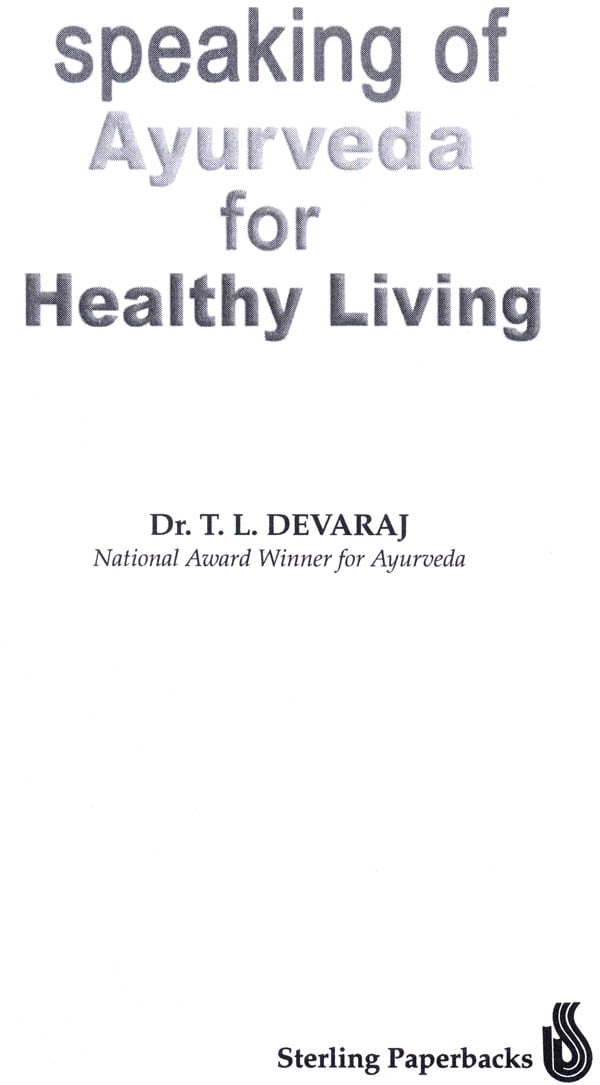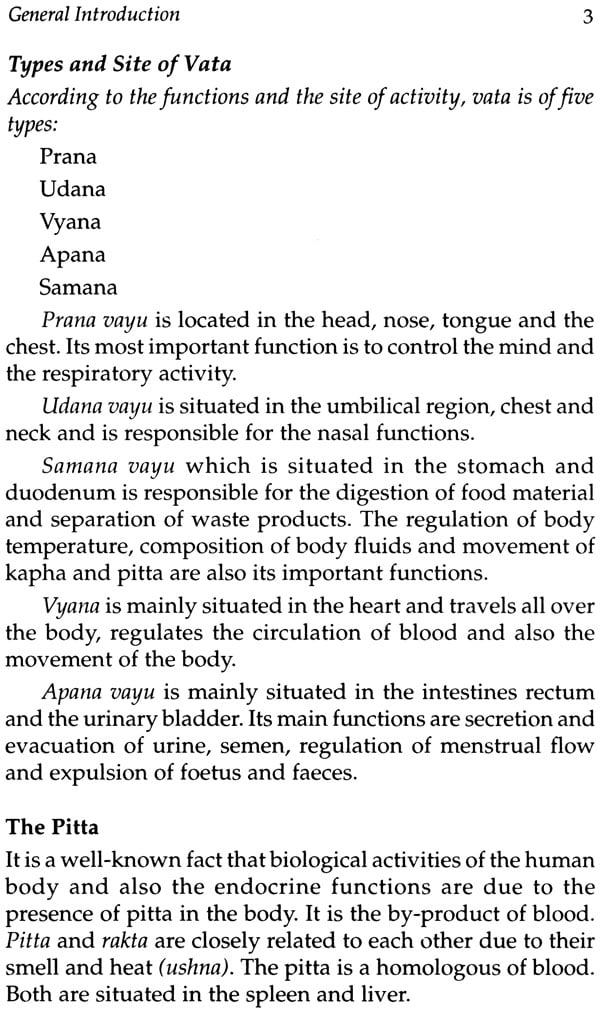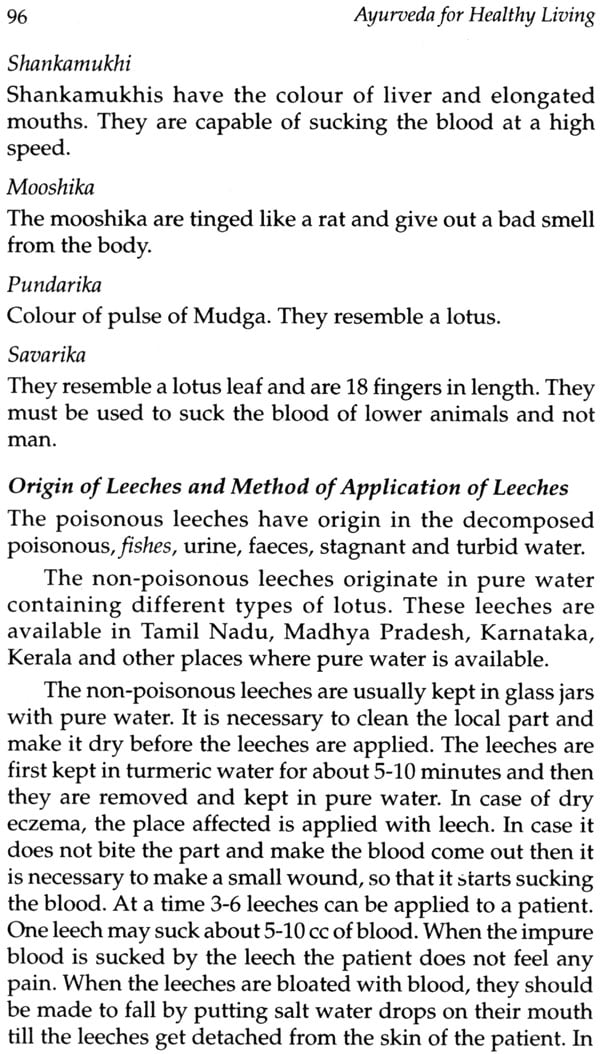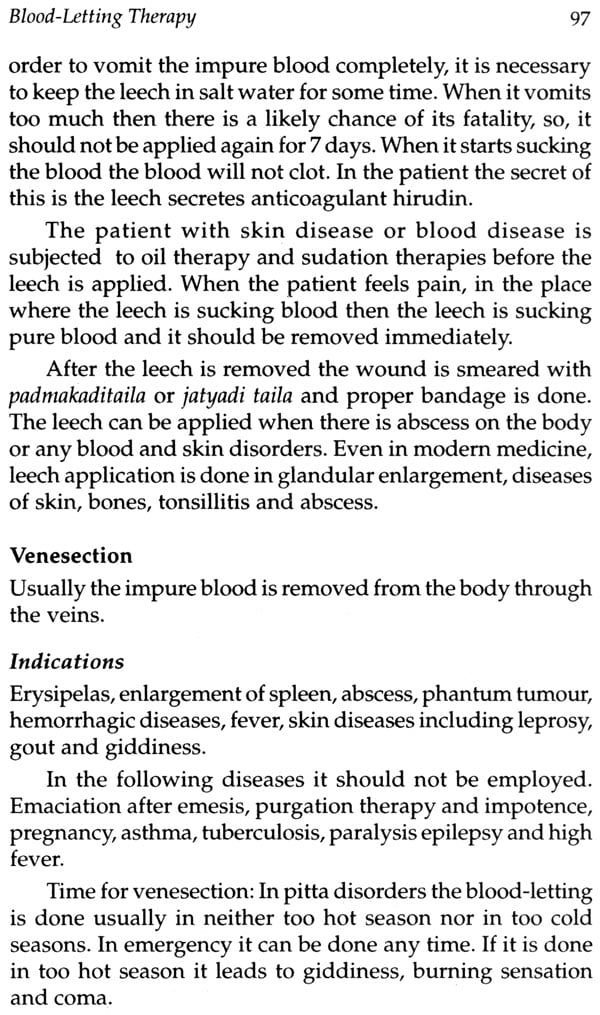
Speaking of Ayurveda for Healthy Living
Book Specification
| Item Code: | NAC400 |
| Author: | Dr. T.L. Devaraj |
| Publisher: | Sterling Publishers Pvt. Ltd. |
| Language: | English |
| Edition: | 2010 |
| ISBN: | 9788120755901 |
| Pages: | 117 |
| Cover: | Paperback |
| Other Details | 8.5 Inch X 5.5 Inch |
| Weight | 160 gm |
Book Description

The general public today are subjected to air, water and food pollution resulting in many diseases. To overcome these, one has to undergo detoxification. The author has written several books on Ayurveda including allied systems of medicine and allopathy for the welfare of the people.
This book, Ayurveda for Healthy Living is meant for each and everyone to keep their body and mind in good health. Ayurveda postulates the Samsodhana therapy or Panchakarma to detoxify and rejuvenate the body tissues. One can live for at least a hundred years by practicing this therapy. This book is a useful guide for readers to keep their physical and mental fitness necessary for discharging their day-to-day duties.
Prof. Dr. T.L. Devaraj is the first National Award winner for his yeoman service to Ayurveda. He is the first Kannadiga to get this coveted award. He is also the recipient of several awards and honours including the International Award for his outstanding contribution to Ayurveda. He is the author of more than 40 books on Ayurveda. His books are exported all over the world and translated into many languages. He is the first professor to write on Panchakarma, Health and Family Welfare and Handbook of Ayurveda Medicine in three languages — English, Hindi and Kannada. His books are praised by eminent people from the field of Ayurveda and also by the public. He has worked as Professor and Principal of Government Ayurveda Medical College, Ban galore and retired as Deputy Director of AYUSH.
I am greatly honoured to present this book on the popular purificatory pentad procedures emphasised in Ayurveda for the well-being of the human community.
The main objective of the medical professionals the world over is to achieve health for all by 2000 A.D. Ayurveda has a vital role in ensuring mental and physical well-being. This book is written with the view of benefiting all other allied systems of medicine including modem medicines. This book enriches the treatment aspects of Ayurvedists too.
With the immense advancement of medical science, a number of diseases which, at one time, were fatal have been routed. Peptic ulcers, colitis, thrombocytopenia, Parkinsonism and other neuromuscular disorders, skin diseases and jaundice cannot be cured by Allopathic system of Medicine. Ayurveda has the cure for all these maladies; It is a well-known fact that modern drugs produce side-effects in the systems of the body and mind. People at large have realised the efficacy of herbal remedies. Even the World Health Organization is giving due importance to the science of Ayurveda.
Diagnosis in Ayurveda is based on the detailed data drawn from the facts pertaining to the individual’s habits, diet, constitution, profession, psychic features, etc; unlike the modern system which basically considers microorganisms as the prime cause for the causation of a disease.
Ayurveda considers the digestive system as the major source of most of the diseases. It believes that disturbance in the digestive and assimilatory mechanism leads to the formulation of (undigested food essence) of various types (toxins) giving rise to diseases. Since the diseases exhibit morbid changes in six stages, (Shad Kriyakalas) beginning with digestive disabilities, a disease can be controlled before manifesting or even cleared if the stages of the diseases are well-studied and principles of treatment instituted in accordance.
Ayurveda uses three major principles in treating a disease depending upon the stage of the disease. They are:
1. Nidan Parivarjana or eradication of the disease, producing factors and imposing preventive steps.
2. Shamana Cikitsa or palliative treatment when the disease is in its early stages.
3. Shodhana therapy or the purificatory technique is implemented when the disease is advanced or when it involves dhatus.
In this book, an attempt is made to emphasise the Shodhana therapy which is one of the most important and advanced techniques of Ayurveda. It is unique as it can be used for preventing the disease, curing the disease and at the same time promoting the well-being of the healthy individual.
The Shodhana therapy is basically a pentad procedure, which involves (1) The Emesis therapy (Vamana Karma) (2) The Purgation therapy ( Virechana Karma) (3) Enema treatment (Vasti Cikitsa) — oil enema therapy (Anuvasana Vasti) or (4) Decoction enema therapy (Niroohavasthi) (5) Nasal insufflation (Nasya Karma). These procedures are carried out with perfect techniques incorporating the Trividha Karmas (Tripordial methods) which are (1) The Poorva Karma, wherein the important oleation and Sudation therapy are carried out according to the norms laid down in classics (2) Pradhana Karma, (operative treatment) in which any suitable procedure among the pentad purificatory procedures is adopted in accordance with the measures stipulated and (3) Paschat Karma (post operative treatment) where, after the procedure, the regimens are prescribed alongwith specific — Vihara (Activities) and suitable line of specific treatment for each disease. This book elaborates on the above procedures essential for the practice of this special Ayurvedic treatment in the field of Medicine.
Ayurveda not only cures the disease but also rejuvenates the body by increasing the immunity against the disease producing organisms. Ayurvedic treatment tones up the system, and acts as a tonic. This book is brought out when the world is searching for an alternative system of medicine to get the ailments cured without deleterious effects on the body.
Since words like vata, pitta and kapha have been used very frequently we have not italicised these words. I hope the readers would receive this book with great enthusiasm as shown to my previous books on Ayurveda.
| Acknowledgements | v | |
| Preface to this Edition | vii | |
| Preface | viii | |
| Chapter 1 | General Introduction | 1 |
| Chapter 2 | Fat Therapy | 12 |
| Chapter 3 | Sweating Therapy | 27 |
| Chapter 4 | Emesis Therapy | 40 |
| Chapter 5 | Purgation Therapy | 50 |
| Chapter 6 | Enema Therapy | 77 |
| Chapter 7 | Nasal Insufflation Therapy | 85 |
| Chapter 8 | Blood-Letting Therapy | 92 |
| List of difficult words used in the book | 100 | |
| Glossary of Sanskrit words | 104 |









